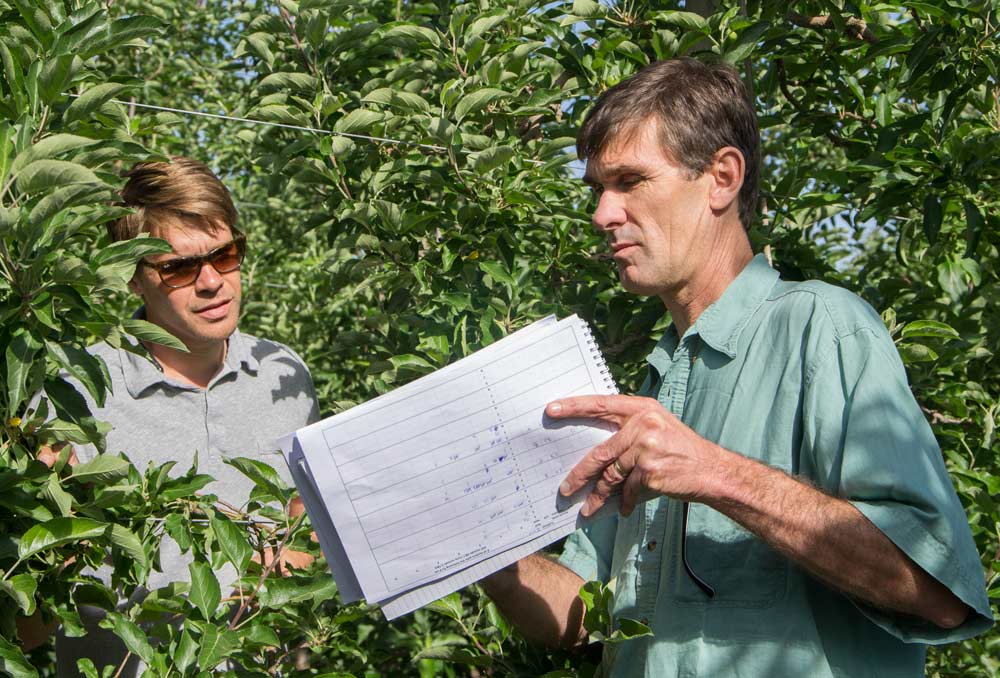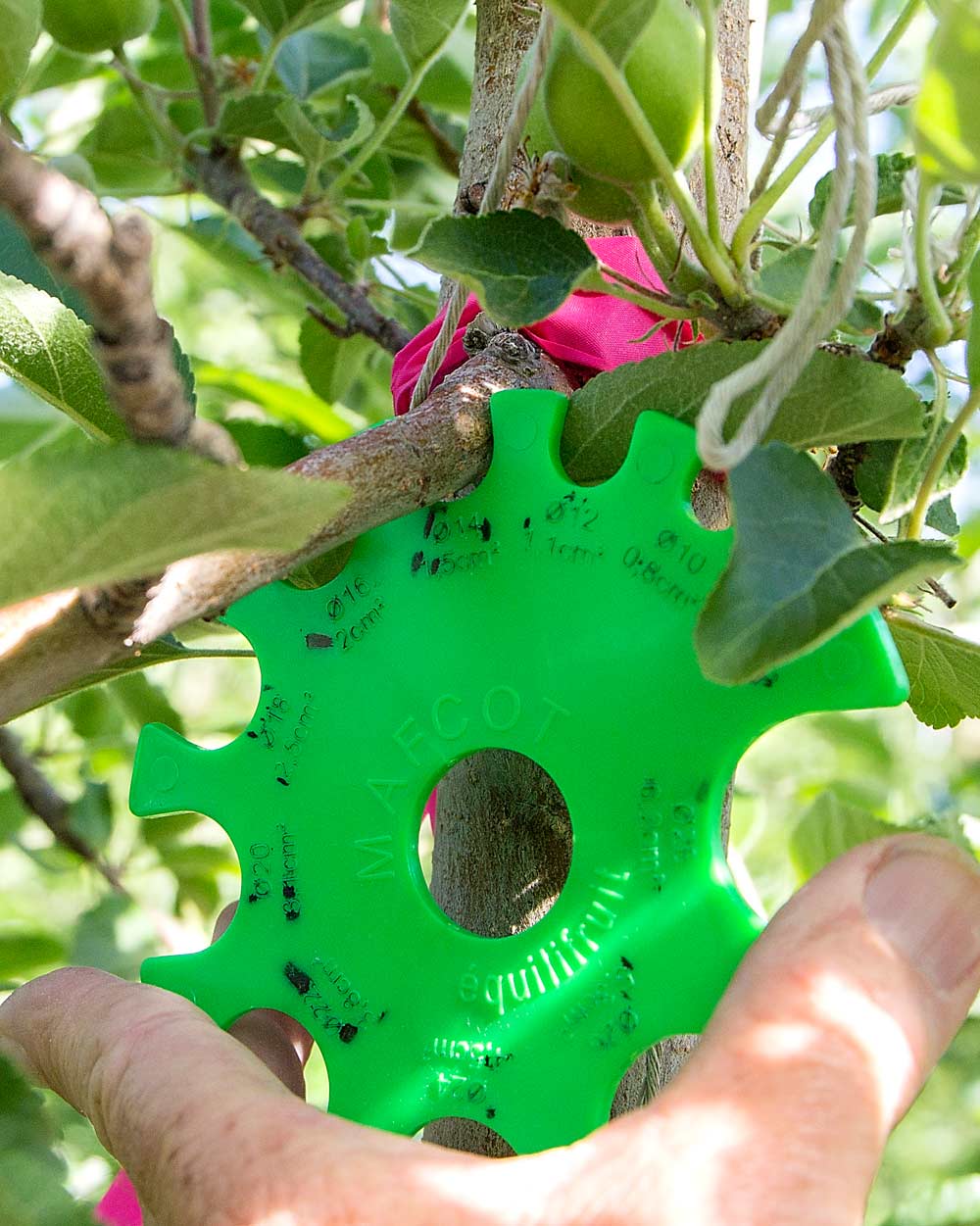
Grower Andrew Sundquist, left, and Ken Breen, scientist for Plant and Food Research New Zealand, discuss the data from a research trial into the effectiveness of artificial spur extinction in a Jazz apple block near Selah, Washington, in June. (Shannon Dininny/Good Fruit Grower)
An apple orchard’s crop load ultimately determines the value of the crop — yield potential, fruit size and fruit quality — and managing crop loads requires precision.
That’s particularly true in modern, high-density orchards with dwarfing rootstocks that produce thousands of flowers per tree.
Growers today employ chemical, mechanical and hand-thinning practices to remove excess flowers and fruit, but a tree’s responses to chemical and mechanical thinning methods are unpredictable, and hand thinning is expensive.
So how can growers better estimate and manage crop loads to achieve their targets?
Following years of study, researchers from New Zealand have found success across New Zealand and Australia with a method called artificial spur extinction, which involves selective thinning of floral buds — the entire fruiting site or five flowers at a time, rather than individually removing flowers as is done with blossom thinning — just before bud break.
They also select and space the fruiting sites at the same time, which is easier and faster and performed in spring when labor might be more available.
The method isn’t intended to entirely replace pruning and thinning, but it enables growers to get closer to their goals earlier in the season, before fruit is even on the tree.
Now, researchers are wrapping up the second of a three-year study into the method’s effectiveness in the U.S. The study in 10 Washington orchards focuses on two high-value varieties: Jazz and Envy.
Both of the trademarked and managed ENZA varieties are offered to a limited number of growers. Jazz is prone to inconsistent crop loads and biennial bearing; Envy can be high yielding, but in conventional systems, quality and return bloom may be negatively affected.
The study is a collaboration among growers of the varieties; ENZA, a subsidiary company of Turners & Growers that holds the global rights to the varieties; and Plant and Food Research New Zealand, the owners of the varieties.
Why crop load matters
A tree’s objective is survival and reproduction; it wants as much fruit as possible. However, that doesn’t necessarily translate to high-quality fruit, with the size, color and eating quality crucial to high-dollar returns.
That’s why crop load so heavily influences success.
At the same time, not all apple varieties are regular bearers with a tendency for natural spur extinction, like Granny Smith and Cripps Pink. Very few spurs die off on biennial bearing trees, and they have reduced ability to initiate return fruiting on newer spurs. Artificial spur extinction could provide a boost to those cultivars.
One of the challenges is that growers often believe that having more flowers offers more flexibility — an insurance policy against late frost or other damaging events that could suddenly shrink their crop.
In a converse way, the insurance policy “isn’t working,” said Ken Breen, scientist for Plant and Food Research New Zealand. “We know that the more flower clusters on a tree, the less predictable the fruit set. Conversely, reduce the flower cluster, the more predictable the fruit set,” he said.
For more than a decade, Breen and others, including Stuart Tustin and Ben van Hooijdonk, have been working in New Zealand and Australia to selectively thin buds on certain cultivars before bud break.
The process involves three steps, beginning in a year the trees are expected to flower heavily: pruning at dormancy before that heavy bloom, removing floral buds before bloom to set up appropriate fruit numbers at the green stage, and tracking production at harvest.
The goal is to reduce competition among a higher number of buds and direct the tree’s resources during the growth period after dormancy to those buds intended to carry fruit to harvest.
The process

A researcher measures each branch to determine the number of buds that should remain. (Shannon Dininny/Good Fruit Grower)
Previous research has shown that trees on dwarfing rootstocks in highly trained systems only need six to seven branches per vertical meter of canopy. “Any more than that doesn’t help with your energy capture,” Breen said.
“All it does is increase shade in the canopy, which reduces fruit quality and yield in the current season and the ability of the developing buds to flower next season.”
So with trees pruned to that specification, growers then measure the caliper of each branch to determine its cropping potential and then add those together to get the cropping potential for the entire tree. The number can be multiplied by the number of trees per acre, with a specific target fruit size, to ascertain the target bins per acre.
For instance, participating growers in the Washington study are aiming for five fruit per squared centimeter for both varieties, based on results from the New Zealand studies. That would be five fruit per 2.5-centimeter caliper branch or 12 to 13 (2.5 x 5) fruiting buds on that branch. From that target, the growers and researchers can determine whether the tree may have too many buds or branches or both.
Further study may show the number of fruit per squared centimeter should be altered to adjust to Washington growing conditions.
Does it work?
The previous research in Australia and New Zealand, which focused on several cultivars including Envy, Jazz and Gala, has shown predictable responses, Breen said. Generally, researchers found that only about half the buds the trees produce are needed.
For instance, as an experiment to understand the physiology of the tree, researchers removed 80 percent of buds on Gala, and by green fruit thinning measured the same light interception (energy capture) as those trees that had no buds removed.
That’s far too many buds to remove in a commercial operation, Breen said. Rather, they should be at 50 to 60 percent, as was done in an Envy research orchard and a large Gala experiment of 55 trees in a commercial block.
Even at those lower rates, the results have been telling: They achieved yields 50 percent more than the national average.
In New Zealand, the industry average is 90 tons per hectare for Envy, but the research blocks comfortably achieved 150 tons per hectare and 90 percent color packout annually without any problem, Breen said.
For Gala, yields even on well-managed grower blocks increased from 100 to 130 tons per hectare.
In a “youngish” Jazz experimental block, the trees produced “especially impressive yields” of between 85 and 90 tons per hectare of fruit, sized at 170 to 185 grams, compared with yields of 70 tons per hectare of 170-gram fruit from conventional trees, Breen said.
However, yields aren’t everything. Because the canopies are much more open, they are more porous to light, which has a positive impact on color development of fruit in the center and lower portion of the tree, he said.
That means two things: one, a higher proportion of the fruit achieve high color grades (such as the Envy packout mentioned above), and two, a greater proportion of the fruit is removed in the first and second picks.
If the results in Washington are anything like researchers have found elsewhere, “I’ll take it,” said Andrew Sundquist, president of Sundquist Fruit & Cold Storage in Yakima, Washington, who grows both Jazz and Envy and is participating in the trial in a Jazz block — not to save money, but to improve crop load estimation.
Sundquist’s company probably spends about $800 an acre to hand thin green fruit in the absence of spur extinction, Sundquist said. “I don’t think it’s really going to cut costs. It’s just the idea to get a better crop load, a more ideal crop load.”
Because Jazz and Envy are two of the most high-value varieties, Sundquist wants to target fruit size and quality as good as he can get it. “And obviously, doing the same thing over and over again isn’t going to get us there,” he said.
Yields often don’t change immediately because the trees need time to adjust, so any yield data from the Washington study wouldn’t be informative yet, Breen said.
However, researchers have detected a color shift in many of the Washington blocks in the first season — for one Jazz block, 78 percent of the fruit was picked in the first two picks on the research trees, compared with just 59 percent of the fruit in the conventional trees.
The first couple of years of the project have been learning experiences for the U.S. growers, who tend to handle tree counts spatially, rather than by limb diameter, said Rick Derrey, North America manager for ENZA.
“We found we weren’t consistent with what we were doing. It’s probably more of a precision-based process than we were used to,” he said.
Generally, Derrey said, they’ve noticed that they are routinely exceeding targeted yields, rather than coming in under target. “If our ideal target is 100 bins per acre, we find by measuring that the capacity is sometimes double that,” he said. “We then know we can either remove more limbs or remove more buds or both.”
So far, one of the biggest things they’ve learned is that they are undercropping branches in the lower parts of the tree, in part due to chemical thinning programs, but also due to stub cuts to shorten the branch and maintain space. “We think it’s best to remove the branch completely and replace it,” he said.
They’ve also found that they are overcropping some smaller branches in trees, leading to biennial bearing on individual branches and trees and limiting the potential for overall consistency tree to tree.
ENZA plans to extend the study into a fourth year to evaluate return bloom following year three and to learn the correct bud count for Washington’s environment, he said. “It takes time for us to better learn how to manipulate these trees,” he said. “It also takes time for the tree itself to adjust.” •
– by Shannon Dininny






Leave A Comment